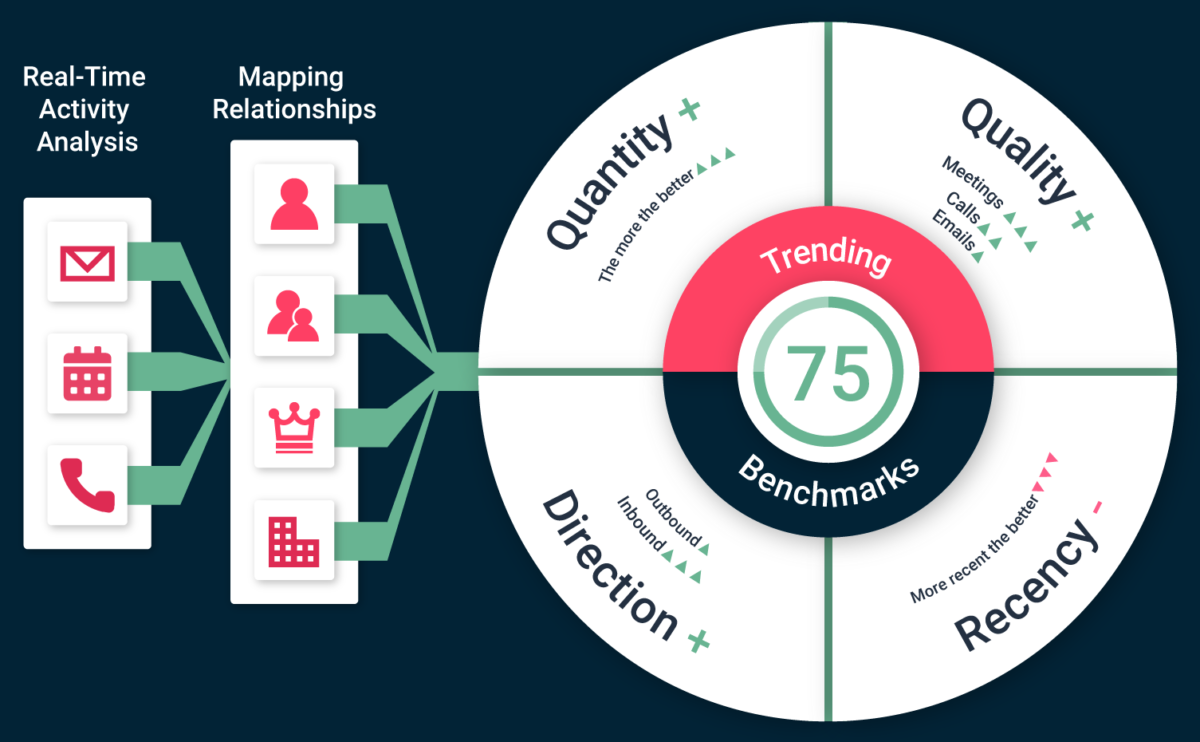Table of Contents
Share this article
Learn from the brightest minds how to predictably and efficiently grow revenue.
Related Content
5 Ways to Use the Ebsta Integration With HubSpot to Improve Sales Performance
How to improve adoption of HubSpot with Ebsta
B2B Sales Benchmarks: 2023 H1 Update
The latest update from the 2023 B2B Sales Benchmarks analysis of over $37bn in pipeline.
How to improve AE quota attainment (according to data)
23% of reps are contributing 83% of revenue. Here's how to solve it (with data)

How to Build an Account-Based Selling Strategy using Revenue Intelligence
One of the key goals of B2B sales is to establish and nurture connections with target customer accounts. These connections provide the anchor points for all of your interactions going forward with that account. Now, note that we didn’t say relationships, we said connections. Relationships are what grows from the initial contact (connections) you make with your customers; they have metrics that can be measured and show how effectively your sales team is strengthening the links your company has with key stakeholders.
So how can you use that insight to understand your prospective customers better? This is where Relationship Intelligence comes into play. Relationship Intelligence enables you to track the engagement that your sales team has with internal contacts and is an aid in understanding how likely that prospect is to convert to a sale.
Table of Contents
Wait a minute… what is an account-based sales or marketing strategy?
Account-based selling strategy is a tactic that creates a list of prospective companies you are interested in having as your customers. The strategy silos each of those companies into their own market, instead of individuals or contacts within them. This enables you to hyper-focus your sales outreach and marketing collateral on each company’s individual requirements or pain-points; thus improving the likelihood of engaging with prospective accounts as you are speaking directly to their needs.
By integrating a targeted approach to your marketing and sales, your focus shifts from attempting to appeal directly to a wide audience, and instead target particular companies which match certain criteria. This criterion is what makes ABS/M an effective strategy, as you are able to place each of your target accounts within its own silo and group those siloes by a common category you know your messaging will resonate with. This approach also makes it simpler for your marketing departments to create content as they know who they are talking to and why making the content personalized to individual groups’ needs.
Gain visibility of relationships and understand who knows who
As you can see account-based selling and marketing when combined are a powerful tool, they can streamline your marketing efforts and optimize your sales prospecting. But like any tool in your sales arsenal, both can be augmented to provide further improvements. By introducing simple changes to the way in which you view your sales staff’s contacts you can unlock the full potential of ABS. Many companies view their sales team’s contacts and relationships as an individual affair – in fact often there is no crossover between sales staff on their own personal connections. This makes life much harder for your sales reps to ‘get in on the ground floor’ with many of your target accounts as it amounts to a cold call or email. But by opening up relationships and connections across all sales staff, you are able to leverage existing relationships to effectively eliminate cold introductions with a vast majority of your targeted prospects.
The easiest and quickest way to implement this is with CRM automation. By automating your CRM input, you automatically capture the last contact points each team member had with prospects, meaning that all your reps know – via your CRM – when the last contact happened with any stakeholder in an account. This effectively creates an ‘Internal LinkedIn’ which reps can use to leverage relationships. By leveraging the relationships that all your reps have across an account, you allow them to work together to open up additional contacts within a target company and increase stakeholder engagement. With the shift in recent years in B2B sales, being able to increase your connections within a target account has become especially important as the number of stakeholders needed to make a purchase decision has also increased. By opening up your whole team’s connections to all members of the team, you not only improve the way your team approaches a target account but also optimizes sales productivity. You can even take it one step further by having visibility on the relationships and connections that each of your reps has, enabling you to effectively assign accounts.
When it comes to assigning accounts to your sales team one important factor to consider is the strength of already existing relationships. It may seem obvious, but many sales leaders don’t use the connections that their reps already have within a target account as a factor when making assignments. The main reason behind this is due to not having a clear view of the relationships that each team member has, either through missing data in their CRM or reps not sharing their contact lists. However, by having your team sharing and leveraging their contacts you can assign target accounts to team members who have connections with either potential advocates or stakeholders, making it easier to drive the sale forward instead of going in cold.
Score engagement to understand the strength of relationships
Another way to improve your Account-Based Selling or Marketing strategies is to implement scoring on your opportunities. This enables you to gauge how well your sales team is interacting with prospects and track prospect engagement with your outbound collateral. If you consider that lack of engagement is believed to be the cause of up to 75% of lost sales, tracking engagement can turn your ABS strategy from a flop to a success.
So what do we mean by scoring engagement? When it comes to understanding interactions between your sales team and a prospect, many companies will look at how many activities have been directed at the account. Just because your sales rep is picking up the phone or emailing on a daily basis doesn’t mean they are engaging with advocates or stakeholders. Engagement measures the response rate on your outreach and awards a score based on the level of interaction, this gives you a deeper insight into how each stakeholder is processing within your sales cycle.
Engagement scoring is one of the core metrics within our Revenue Intelligence Platform, it gives you a holistic view of each relationship by tracking every activity, including emails, meetings and calls, and scoring the interaction rates around each. Our Ebsta Score is built around a simple formula based on the following factors:
- Type & Quality of Interaction
- Volume of Interactions
- Direction of Interactions
- Recency of Interactions
The more interactions you have across the account – the higher the Ebsta Score, the better chances of conversion.

Use Relationship Data to Prioritise Accounts
When starting out with your ABS campaign there is a tendency to generate a large list of potential targets and set your sales and marketing teams off without any further consideration. While this can work for some companies (especially if you operate in a smaller, niche market) but for most, it places your teams in an impossible position. We have spoken about creating ICPs (or Ideal Customer Profiles) previously and these are a must for any account-based campaign. By creating a focused profile for your customer type you can review the list of potential targets and assess whether these are actually viable accounts to spend resources to acquire. Furthermore, as you profile the companies based on certain criteria you can actively determine their priority.
Determining the priority depends on what your business goals are and how you are approaching your ABS strategy. For example, you may be looking to increase revenue within a specific period of time, therefore, making prospective accounts with higher values more of a focus for your first wave of outreach. Additionally, you may be looking to complete deals of any size quickly with medium resource spend, so assessing the targets on their intent and likelihood of success becomes the major factor. With either of these driving factors, it is important to build a path through your list. With Ebsta’s Opportunity Insights, you can use your historical data to map out your ideal customers based on the types of companies you have had successful deals with in the past, making it easy to identify and prioritize your accounts.
Final Thoughts
As you can see, integrating relationship data into your account-based selling process yields some additional insight and depth to your strategy which can be used to optimize the strategy. By further improving your internal processes and gaining additional insights that relationship data can provide you with enables you to refine your targeting, optimize your outbound messaging and improve your KPI tracking.
Utilizing relationship data does not just help you to plan your strategy by building a picture of how effectively your team is building relationships with key decision-makers. It also enhances your ability to convert advocates within account sales leaders and managers by identifying where additional resources are needed to reduce opportunity risk.
If you are ready to take your account-based selling strategy to the next level speak to our team who will help you to gain greater insight with our Revenue Intelligence Platform.


